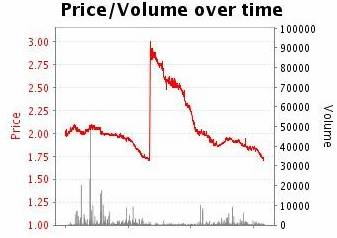Trading
Buying and selling is what trading is all about. If you can sell at a higher price that what you bought you'll make a profit.
With the advent of online Betting Exchanges (e.g. Betfair) its is now possible to buy and sell odds.
You SELL odds when you BACK and you BUY odds when you LAY - this is a bit counter-intuitive - just always remember .... to make a profit you need to LAY at odds lower than you BACK.
Here's a Betfair graph showing how the odds moved over time for a particular event.
If you BACKed at point A (2.5) and LAYed at point B (2.15) you would have made a profit.
If you'd LAYed at point A and BACKed at point B then sadly you'd have made a loss.
But the odds graph can go up as well as down

Things were looking OK for some one who had BACKed at the start of this football match the odds were going down nicely and a LAY at odds of 1.75 would have made a nice profit but suddenly a goal was scored and the odds shot up vertically and would have let the BACKer looking at a loss, The odds did return again to 1.75 but that was never guaranteed.
Here are some tips for the newcomer to Betfair and trading.
Start Small
There’s a lot to learn in the beginning, and most of these things you can’t just read - you have to experience them. Trying out your trading skills by writing down your trades on a piece of paper rather than actually submitting them can be a good learning experience. But paper trading is never really the same as actually putting some money in the markets, so you should not paper trade for more than a day or two. When you do start placing best start out small and use minimum bets at first until you get the hang of things.
Don’t increase your stakes to fast
Theoretically it is the same thing to trade with £0.10/point and £100/point, but in reality there are some big differences. Apart from being more difficult harder to get your bets fully matched , there is a psychological side to it. To be -£2000 after a trading session is way harder for your mind than to be -£20, especially if it’s money you really can’t afford to lose. So don't use money you can't afford to lose. Never put yourself into debt and danger.
Find your market
A common mistake by new traders is to jump around between different sport markets. Of course it’s a good idea to try some of them out, but you should pretty fast choose one or two sports and stick to them. Use 95% of your trading time on these markets, and the other 5% to try out new ones. It is better to be good in one or two sports, than to be mediocre in many..
Love to learn
Read all blogs, forums and books you can find that touches the subject! Of course there is a lot of “bad” information out there, and most sites just want to sell you lousy “trading systems” (don’t buy them, they’re all crap anyway). But on all pages you can always find something useful, just learn to filter out all the sales pitches and you have an ocean of knowledge!
Learn to accept losses
Losses and bad trades is a part of the game. Even if you are a good trader and make all the right decisions, you will leave some markets with red number. You will even leave days, weeks and months with red numbers sometimes! Of course you should cut your losses as soon as possible, but even the best trader some times hangs on to loosing positions ending up in a big red number. It’s psychologically challenging to end a full working day with a negative result, but it happens to everyone. When it happens to you (and it will, there’s no way around it) you have to learn to accept it. Just turn off the computer, get outside and walk. When you get back, try to analyze what (if anything) went wrong, and don’t get back on the markets until you feel recovered.
Track your results
Keep records. Write down your results and your working time in a text document or a spreadsheet. This will help you keep track on what you actually make per hour, something that will make it easier to take losses as you know that you make money in the long run.